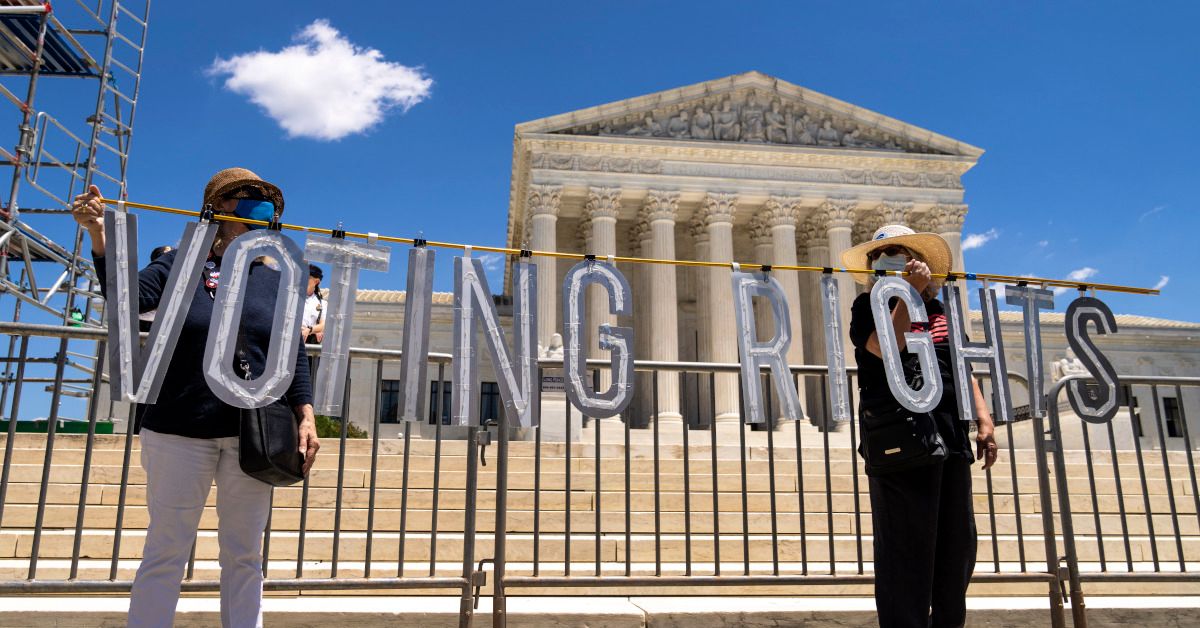In June 2021, a filibuster by Senate Republicans held up the "For the People Act," a sweeping piece of legislation designed to introduce federal reforms of elections in the United States, including expanding voter registration and early voting provisions, increasing public funding for campaigns, and making Election Day a federal holiday.
A set of compromise measures put forward by moderate Democratic Sen. Joe Manchin of West Virginia could provide a path forward for the reforms, but for now, their progress has been stalled.
On June 22, Mother Jones highlighted what it characterized as a glaring democratic deficit in the vote to halt the For the People Act, writing that:
The 50 Democratic senators who support the For the People Act (or least Sen. Joe Manchin’s compromise proposal keeping some key elements of the bill while excluding others) represent 43 million more Americans than the 50 Republican senators who oppose it, according to data compiled by Alex Tausanovitch of the Center for American Progress. Yet because of the 60-vote requirement to pass most legislation, 41 Republican senators representing just 21 percent of the country can block the bill from moving forward, even though it’s supported by 68 percent of the public, according to recent polling.
The composition of the U.S. Senate — two members from each state, regardless of each state's population — has always disproportionately favored states with smaller populations. This is not by accident, but rather is a feature of the way the United States' bicameral national legislature is constructed, with House districts based on population size, and the Senate designed, in principle, to counter-balance that influence by giving smaller states outsized power.
Nonetheless, the figure calculated by Alex Tausanovitch from the Center for American Progress, and presented by Ari Berman for Mother Jones — that the 50 Republicans opposed to the For the People Act represented 43 million fewer people than the 50 Democrats who supported it — was remarkable and, as it turns out, accurate.
The Democratic-majority House passed H.R. 1, the For the People Act, in March 2021. Its companion bill in the Senate, S. 2093, was introduced on June 16. On June 22, senators debated a motion to proceed, followed by a motion of cloture on that motion to proceed. A motion of cloture is a proposal, signed by at least 16 senators, to end the current debate on a particular motion, and advance the underlying legislation, with the ultimate aim of holding a full vote on the bill.
In order to progress the For the People Act, Democrats in the Senate needed a three-fifths majority on the cloture motion on June 22. However, the vote ended 50-50, along strict party lines, thus effectively bringing the bill's progress to a halt.
All 48 Democratic senators voted for the motion, along with independents Bernie Sanders of Vermont and Angus King of Maine, who both caucus with the Democrats. All 50 Republican senators voted against the motion, and therefore against the advancement of the underlying legislation.
Using the most accurate and recent data available — the resident population for all 50 states, taken from the Census Bureau's "2020 Census Apportionment Results" — we calculated the total population represented by each senator. A quick housekeeping note: In reality, each individual senator represents a whole state, but because, in some states, the two senators voted differently, we interpreted each individual senator as effectively representing half the state's population, for the purposes of these calculations.
A detailed breakdown can be found here. In summary, though, the 50 senators — Democrats and independents — who voted for the motion, effectively represent close to 187 million people. By contrast, the 50 Republican senators who voted against it effectively represent 144 million people. That's a difference of slightly more than 43 million people, exactly as Tausanovitch and Berman stated.

